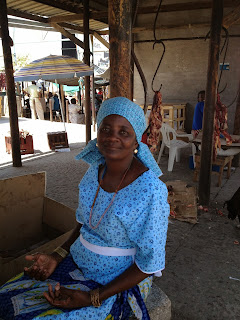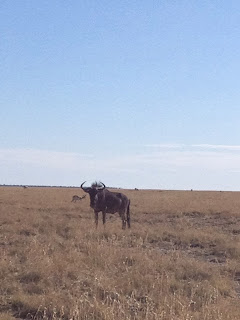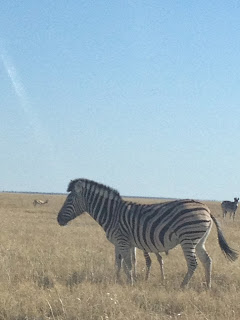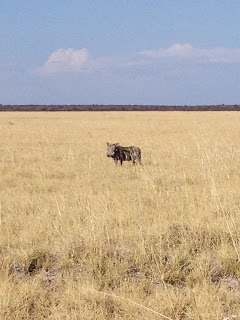Wander around long enough in the African market in Oshakati, and you will meet more people than you'd expect. The sellers -mainly women- are just as interested in getting to know about you and why you're here as trying to sell their items. Everyone is friendly, and you can feel the warm atmosphere- as well as the 40 degrees Celsius temperature.
Above and Right: The friendly people who chatted with us
during our local market experience.
Everything is so different and interesting, from the cow heads collecting flies on the floor to the lethal bow and arrows that can kill a lion. But the food may be the best, and tastiest, part. The traditional dishes surround you with foreign scents as you watch them prepare the food over small coal pits dug out in the concrete. I was only allowed to eat an orange colored, deep fried fish with local spices and chips (French fries) though, because my parents didn't trust any other dishes! Too bad I couldn't try anything else, because everything looked really good.
Some of the many dishes and items in the Oshakati market.
Above: The kitchens made from concrete and pots which were all over the market. Below: a cow head, heart and hooves, which are put in soup and stew whole. My mom said no to trying these before I could even ask! ;(
Above: different items used in cooking; the middle left bowl holds Mopani Worms, which are worms that come from inside the Mopani trees and can be eaten dried or in soup. Below: a fruit known as the Okongo orange that smells kind of like orange soda.
The bowls above are used to grind corn, but my mom and I are thinking of getting one for house decoration instead. Below: the orange deep-fried fish I was allowed to try.
Sunday, December 8, 2013
A WIMPY Thanksgiving
Hopefully your history class has taught you by now that Thanksgiving is solely an American holiday, and doesn't happen all over the world. If not, then I highly recommend you go back to third grade ;)
Being an American, I didn't really want to just give up the delicious turkey holiday, but when you ask a local if they eat turkey here, and he says, "You mean the shiny blue bird? With big green feathers? Nope," some sacrifices have to be made. So, instead of turkey, my family woke up early and got in the car for a meal at WIMPY's.
The African Turkey
WIMPY's is kind of like Denny's, except it has an African twist- a lot more meat. But the service is faster than the usual hour or so of waiting one must endure to get any restaurant food. Usually we don't eat out much. But electricity is expensive here, so an oven on most of the day is not a good idea.
The food was good, can't complain there. I do question the thoughts of whoever came up with the idea to name a restaurant WIMPY's though...

Being an American, I didn't really want to just give up the delicious turkey holiday, but when you ask a local if they eat turkey here, and he says, "You mean the shiny blue bird? With big green feathers? Nope," some sacrifices have to be made. So, instead of turkey, my family woke up early and got in the car for a meal at WIMPY's.
| science.org.uk |
WIMPY's is kind of like Denny's, except it has an African twist- a lot more meat. But the service is faster than the usual hour or so of waiting one must endure to get any restaurant food. Usually we don't eat out much. But electricity is expensive here, so an oven on most of the day is not a good idea.
The food was good, can't complain there. I do question the thoughts of whoever came up with the idea to name a restaurant WIMPY's though...

 |
| Our memorable Thanksgiving at WIMPY's. Photo courtesy: my mom. |
Monday, November 25, 2013
Cow Tongue, Anyone?
Labels:
:P,
Cooking,
Cow Tongue
Location:
Ongwediva Ongwediva
Saturday, November 23, 2013
I previously attended a two day dance workshop hosted by Stanley Mareka, one of Windhoek's best dancers and teachers. He has danced all over Europe and Africa and started his own elite dance crew in Windhoek. The four-hour-a-day workshops were intense- Stanley didn't exactly believe in being tired! But my hard work paid off. I preformed with his dance crew for hours in the streets and at an entertainment lounge on the third day. Stanley told me I have a lot of potential and that he wished he could work with me more to help me expand my horizons as a dancer!
The workshops and performances are a new highlight of my time here in Namibia! :)
Tuesday, November 19, 2013
¿Que es un taco?
(What is a taco?)
For a country that loves their meats, I was astonished to find out that NO ONE knows what a taco is. Or a burrito. Or a taquito. Or an enchilada! So now I get to make some Mexican food and bring it to my dance class so they can all try it out. This will be fun...
Safari Adventure Comes to a Close
We left for our long drive back to civilization after viewing Halali's watering hole one last time. But the trip back wasn't without numerous visits to other smaller watering holes along the way.
One of these inferior watering holes was known for its sightings of leopards, and we made it our first stop. As we drove closer to the watering hole the trees became taller and more lush. It was easy to look around and see how the leopards must love it here. The leaves are dense enough that only little speckles of light shine through on their branches, which would make the leopard's spotted coat be a natural form of camouflage. Leopards could hide easily, unnoticed by the game animals that treaded below. Sadly, I don't have any great pictures of these elusive cats, but the watering hole had a massive turnout. An uncountable number of zebra, springbok, and giraffe showed up as we pulled up beside the hole, and all of them flocked to get a drink.
It was exciting to see all of them together, and it kind of felt like that beginning scene in Lion King.
(I will have a link to this video soon)
A male Zebra decided to make a drastic exit, realizing he had been left behind by his herd of ladies. We saw them later by the road as we drove off, Mr. Zebra was still pretty angry.
But the Zebra drama didn't end there. We drove by the spot that we had seen lions at again in hopes of seeing them one more time. What we found was a Zebra who had had enough of her annoying comrades.
(link coming soon)
We took a bathroom stop afterwards, and enjoyed seeing the white elephants from the fenced in area that surrounded the out house. Of course, the out house wasn't very enjoyable...
On our way out, we passed though Namutoni one last time, and I found out that grilled ham, cheese, and tomato sandwiches are actually really good. Since it was our last trek, we took another detour -called Stinkwater- in hopes of seeing flamingoes, but came up unsuccessful, since the drought had dried up the Etosha pan so we had nothing to see. Or so we thought. The road was covered in elephant poop, which are the size of large rocks. My brother and I convinced my dad to run over them as we drove, and we all cracked up when we heard the huge thud. I mean how many people can say they made a game out of running over elephant turds?!?
During the last 10 kilometers, we saw huge herds of zebra, springbok, gemsbok, and wildebeest grazing. We stayed there watching them for a while, realizing that we would be leaving soon. I didn't want to go. Etosha was like entering a whole other world, and it was a place I'll remember forever.
We drove out of the park, already planning our next trip here.
Halali Watering Hole
We arrived at the rest camp just as the sun began to set, and walked over to the watering hole to find a black rhino! Later that night we saw four more lions, a hyena and three more rhino there, all at the same time!
I rose early again the next morning, and caught some great shots of the Moringa watering hole before the springbok showed up...
Day Two:
We woke up early and headed to Namutoni's private watering hole, finding a large herd of Zebra that had come for a quick drink.
After breakfast we were back on the road. It would be another 75 kilometers until we reached the next rest camp, Halali. But it took us all day to get there because of all the animals we found along the way!
The animal above is called a dik-dik :) upon seeing us it froze, and I got a nice close up view of Africa's "Bambi." Below: we intercepted a large herd of Zebra, along with a fair amount of Kudu and Springbok, who were making there way to a nearby watering hole!
After breakfast we were back on the road. It would be another 75 kilometers until we reached the next rest camp, Halali. But it took us all day to get there because of all the animals we found along the way!
The animal above is called a dik-dik :) upon seeing us it froze, and I got a nice close up view of Africa's "Bambi." Below: we intercepted a large herd of Zebra, along with a fair amount of Kudu and Springbok, who were making there way to a nearby watering hole!
The spiral shaped horns make sure you cant confuse the Kudu with anything else.
Below: A giraffe bends down to take a drink at the watering hole, which makes one realize how tall they really are...
Above: we took a detour and ended up near the Etosha Pan (a massive lake in the middle of the park) and some wildebeest!
The Best Parts of The Day
At first, all we had seen was four grey blobs out on the horizon, but the closer we drove, the bigger they became! The four monstrous elephants crossed right in front of us! They are so massive that all you can do is just sit there filming in awe as they cross by. One turned and began walking towards us for a moment, and my heart almost stopped. We drove by the other car after they had all passed, and we both flashed each other a big thumbs up. (I will have a link to this elephant crossing video soon, promise)
But the excitement didn't stop there. It is VERY rare to see lions at Etosha, so seeing four of them cross in front of your car is jaw dropping. (click on the link to see one of them cross the road in front of us!)We could all see the huge muscles on the animals as they walked by, which is pretty intimidating when you know that the only thing between you becoming dinner is your car window.
Thursday, November 7, 2013
Safari Adventure: Day 1
The first day was amazing. Once inside the park, all we had to do was drive a few kilometers through a flat grassland area and instantly we found a whole bunch of springbok, gemsbok, blue wildebeest, warthogs, giraffe, zebra, and even a grey elephant! All the animals were grazing right by the road!
The giraffe above reminds me of the British soldiers in London!
This was the outdoor shower for each room, if you couldn't tell what the metal square sticking out from the tree was.
The giraffe above reminds me of the British soldiers in London!
The first hotel we stayed at was the Namutoni Rest Camp, which was previously a German fort before Etosha became a national park. So, I got a quick history lesson at the museum: It was used during the Battle of Namutoni, on January 28, 1904, during which 500 of King Nehale Lya Mpingana of Ondonga's warriors attacked the fort, which was destroyed the next day. Try saying that five times fast.The museum had a lot of artifacts from the battle as well.
Turns out the park itself was actually called Etotha by the natives, which meant 'the place where no plants grow,' but early European traders couldn't pronounce it, so they called it 'Etosha' instead. The fort name was a European adaption of the Oshindonga spelling Onamutune, which meant 'a place we can see from far away' because the fort is higher than the flat land around it.
Besides being a pretty cool German fort, the hotel had a really good buffet and dining area. In the center of the outdoor eating area is a giant bonfire that is lit every night. It also had its own private watering hole, a resting hut, and outdoor showers with the rooms, which were made with a native influence.
Subscribe to:
Comments (Atom)





























































